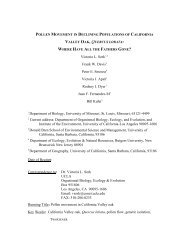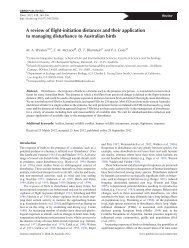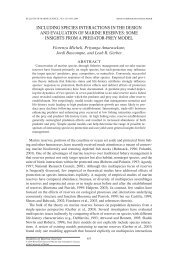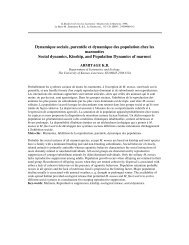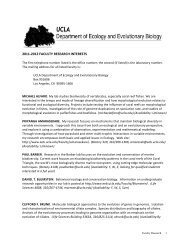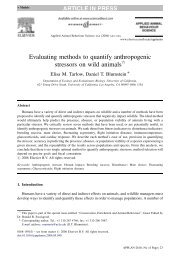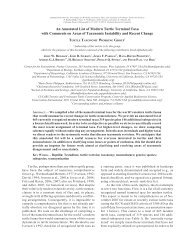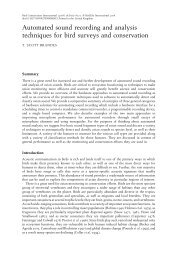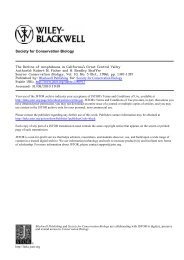newsletter - UCLA Department of Ecology and Evolutionary Biology
newsletter - UCLA Department of Ecology and Evolutionary Biology
newsletter - UCLA Department of Ecology and Evolutionary Biology
Create successful ePaper yourself
Turn your PDF publications into a flip-book with our unique Google optimized e-Paper software.
MAY & JUNEUPCOMINGALUMNIEVENTSA Fly’s Eye View <strong>of</strong> SensoryIntegration <strong>and</strong> BiomechanicsMark Frye, Assistant Pr<strong>of</strong>essor<strong>Department</strong> <strong>of</strong> Integrative<strong>Biology</strong> <strong>and</strong> PhysiologyThursday, May 19, 20112Times <strong>and</strong> locations will beannounced. For moreinformation, go to“The Year <strong>of</strong> the New Life Sciences” atwww.lifescienceslectures.support.ucla.eduThere is onemore lecture in theLife Sciences at <strong>UCLA</strong>speaker series for2010-2011!The 14th Annual <strong>Biology</strong> Research Symposium was held on May 11, 2011 at the <strong>UCLA</strong> CaliforniaNanoSystems Institute, with a talk from 4:00 to 5:15 PM. At the Symposium, faculty, graduate students,undergraduates, research fellows, <strong>and</strong> alumni meet to see <strong>and</strong> informally discuss the research that istaking place in the <strong>Department</strong>. Our speaker this year was Dr. Michael Bell, a <strong>UCLA</strong> <strong>Biology</strong> alumnus <strong>and</strong>Pr<strong>of</strong>essor <strong>of</strong> <strong>Ecology</strong> <strong>and</strong> Evolution, SUNY Stony Brook.Check out the latest addition to our website, EEB TV at www.eeb.ucla.edu/eebtv.php! We post faculty<strong>and</strong> guest lectures, commencement speakers, <strong>and</strong> videos <strong>of</strong> our faculty giving talks elsewhere. Nowplaying: Dr. Nina Jablonski on “The Evolution <strong>of</strong> Skin Pigmentation, Dr. Blaire Van Valkenburgh on “The<strong>Evolutionary</strong> History <strong>of</strong> the Domestic Dog,” <strong>and</strong> many more!You are invited to the 2011 EEB Commencement Celebration! We’d love to see you there. It will beheld on Sunday, June 12, 2011, from 9:00 AM to about 11:00 AM in Wilson Plaza. The speaker will beGary Small, MD. Dr. Small (a ’73 <strong>UCLA</strong> Zoology alum) is a pr<strong>of</strong>essor <strong>of</strong> psychiatry <strong>and</strong> director <strong>of</strong> the<strong>UCLA</strong> Center on Aging at the Semel Institute for Neuroscience & Human Behavior. His research,supported by the National Institute <strong>of</strong> Health, has made headlines in the Wall Street Journal, New YorkTimes, <strong>and</strong> USA Today. Scientific American magazine named him one <strong>of</strong> the world’s leading innovatorsin science <strong>and</strong> technology. Dr. Small lectures throughout the world <strong>and</strong> frequently appears on TheToday Show, Good Morning American, PBS, <strong>and</strong> CNN. He has written five books, including The NewYork Times best seller, The Memory Bible. If you’d like to attend, please email the EEB UndergraduateOffice at eebundergrad@lifesci.ucla.edu. Please note that seating may be somewhat limited; pleaseRSVP early.The next <strong>UCLA</strong> Alumni Day will be Saturday, May 21, 2011! Come back to <strong>UCLA</strong>, <strong>and</strong> join otheralumni to celebrate being a Bruin. Keep an eye on www.alumniday.ucla.edu/2011/ for news! Explorethe program <strong>and</strong> register online at www.alumniday.ucla.edu/2011/. We look forward to seeing you atthe EEB table at the Info Fair!
FACULTY NEWS AND RESEARCHOne <strong>of</strong> the goals <strong>of</strong> this <strong>newsletter</strong> is to helpyou stay in touch with the latestdevelopments in biology. Never before havethe biological sciences played such apressing role in society, ranging from theinnovations emerging from genomics <strong>and</strong>computational biology to the biologicalchanges caused by global climate change<strong>and</strong> l<strong>and</strong>scape alterations. Our facultyconduct high-pr<strong>of</strong>ile, cutting edge research.Here’s what we are doing now!Some major awards received recently by ourfaculty: Cheryl Ann Zimmer received theNational Science Foundation’s DistinguishedService Award, Dimensions <strong>of</strong> BiodiversityProgram in Fall 2010, <strong>and</strong> Richard Zimmerreceived a Distinguished Service Award fromthe National Science Foundation for his rolein co-directing the agency’s researchinitiative on Ocean Acidification. PattyGowaty was appointed a Fellow <strong>of</strong> theSociety <strong>of</strong> <strong>Biology</strong> <strong>and</strong> was elected anEmerita Fellow <strong>of</strong> the new InternationalOrnithological Union, <strong>and</strong> Daniel Blumsteinwas appointed a Fellow <strong>of</strong> the Society <strong>of</strong><strong>Biology</strong>.chelonian inhabitants. These researchersact as ‘evolutionary detectives,’ piecingtogether how the tremendous diversity inliving chelonians today evolved from acommon ancestor that lived millions <strong>of</strong> yearsago. DNA sequences from modernchelonians provide important clues fordetermining the evolutionary path followedby their progenitors, said co-author GrahamSlater, a National Science Foundation–funded <strong>UCLA</strong> postdoctoral scholar inecology <strong>and</strong> evolutionary biology.“The results show a surprisingly strongstatistical correlation between habitatchange <strong>and</strong> significant adjustments in bodysize. Chelonians living in marine or isl<strong>and</strong>habitats have an optimal body size severaltimes larger than their cousins on themainl<strong>and</strong>, said first author Alex<strong>and</strong>er Jaffe,a high school student at Harvard–WestlakeSchool in North Hollywood, Calif. Marineturtles have the largest optimal shell length(about 4.5 feet), followed by isl<strong>and</strong> tortoises(approximately 2.5 feet), while freshwater<strong>and</strong> mainl<strong>and</strong> chelonians are several timessmaller (roughly 1 foot).two full summers <strong>and</strong> was able to turn hisresults into a first-authored paper — a featrarely accomplished by high schoolstudents. ‘Being part <strong>of</strong> this research grouphas been an incredible opportunity for me,’Jaffe said. ‘I can't say how grateful I am.Not only did I learn the tools <strong>of</strong> the trade,especially in the lab, but also what it is like tostart <strong>of</strong>f with an abstract question <strong>and</strong>address it through data collection <strong>and</strong>interpretation.’ Jaffe hopes to studybiological sciences <strong>and</strong> pursue furtherresearch in college. ‘Alex<strong>and</strong>er was ready totake intellectual ownership <strong>of</strong> a project,’Alfaro said. ‘In addition to being a veryconscientious young scientist, Alex<strong>and</strong>erreally showed an interest in the questionsthat we are asking <strong>and</strong> in getting the data toanswer those questions.’ This research wasfederally funded by the National ScienceFoundation.”From the <strong>UCLA</strong> Newsroom: “Biologists fromthe <strong>UCLA</strong> Division <strong>of</strong> Life Sciences havereported the first quantitative evidence for anevolutionary link between habitat <strong>and</strong> bodysize in turtles <strong>and</strong> tortoises. The study,whose lead author is a high school studentvolunteer in the laboratory <strong>of</strong> <strong>UCLA</strong>evolutionary biologist Michael Alfaro, iscurrently available online in <strong>Biology</strong> Letters, ajournal <strong>of</strong> the Royal Society. It will appear ina print edition later this year. Turtles <strong>and</strong>tortoises, also called chelonians, represent adiverse group <strong>of</strong> reptiles that have beenpresent on Earth for more than 200 millionyears. The 330 species <strong>of</strong> present-daychelonians can be found dwelling on remoteisl<strong>and</strong>s, traveling across vast expanses <strong>of</strong>ocean, <strong>and</strong> living in desert <strong>and</strong> freshwaterhabitats on every major continent.“Even more surprising than the wide variety<strong>of</strong> places animals call home is the vastdisparity in their body sizes. The largestchelonians weigh over 1,000 pounds <strong>and</strong>are more than 6 feet in length, while thesmallest weigh just a few ounces <strong>and</strong> wouldeasily fit in the palm <strong>of</strong> your h<strong>and</strong>.Combining statistical computer modelingwith genetic data <strong>and</strong> the fossil record,Alfaro, an associate pr<strong>of</strong>essor <strong>of</strong> ecology<strong>and</strong> evolutionary biology, <strong>and</strong> his colleaguesdemonstrated that different environmentshave specific optimal body sizes for their“<strong>Evolutionary</strong> biologists have long assumedthere is a connection between habitat <strong>and</strong>body size in chelonians, but it was notpossible until recently to show quantitativeevidence for the relationship, Alfaro said.Chelonians have had a special place in thehistory <strong>of</strong> evolutionary biology due to theattention given them in the writings <strong>of</strong>Charles Darwin, Alfaro said. Giant isl<strong>and</strong>tortoises found in the Galapagos <strong>and</strong>Seychelles provide a classic example <strong>of</strong>‘isl<strong>and</strong> gigantism,’ a well-observedphenomenon in which an isl<strong>and</strong>-dwellingspecies evolves to be much larger than itsmainl<strong>and</strong> counterparts. Because theyprovide uniquely isolated habitats, isl<strong>and</strong>sare regarded as natural experiments inevolutionary biology, according to Alfaro.‘Our study was focused on testing whetherthere was any evolutionary signal in support<strong>of</strong> the idea that being on isl<strong>and</strong>s allowed thetortoises to evolve large size,’ he said. Whileit is clear that habitat is an important signal inthe chelonian evolutionary tree, the specificecological conditions that trigger the changein body size are more difficult to determine,Alfaro said.“Jaffe, a senior at Harvard–Westlake School,started volunteering in Alfaro's laboratorywhen he was 16, after e-mailing Alfaro abouthis interest in conducting research. Jaffespent almost 30 hours a week in the lab for!From Pr<strong>of</strong>essor Paul Barber: “In summer2 0 1 0 , w e o p e n e d t h e I n d o n e s i a nBiodiversity Research Center in Bali,Indonesia. The goal <strong>of</strong> the center is topromote biodiversity <strong>and</strong> conservationscience in Indonesia, one <strong>of</strong> the world'smost diverse marine <strong>and</strong> terrestrialecosystems. This is providing a uniquetraining opportunity for researchers <strong>and</strong>students from <strong>UCLA</strong> <strong>and</strong> other USuniversities.”From <strong>UCLA</strong> Today: “<strong>UCLA</strong> is developing abiodiversity research center in Bali,Indonesia, that will support research <strong>and</strong>educational collaboration between <strong>UCLA</strong><strong>and</strong> three universities in Indonesia: UdayanaUniversity, Diponegoro University <strong>and</strong> theState University <strong>of</strong> Papua, as well as theSmithsonian Institution. <strong>UCLA</strong> has beenawarded a $650,000 grant from the U.S.Agency for International Development todevelop the Indonesian BiodiversityResearch Center, which is scheduled toopen this June.3
the evolution <strong>of</strong> cooperation (Nonacs, 2011,Monogamy <strong>and</strong> high relatedness do notpreferentially favor the evolution <strong>of</strong>cooperation. BMC <strong>Evolutionary</strong> <strong>Biology</strong>11:58). Dr. Nonacs concludes Nowak et al.may be correct in advocating that modelingthe evolution <strong>of</strong> cooperation through agene's eye perspective may sometimes bemore accurate than actor-based inclusivefitness models. Nevertheless, interactionswith kin are very important in affectingevolutionary trajectories, <strong>and</strong> kin selection islikely to continue as a major organizingconcept for underst<strong>and</strong>ing social behavior.Dr. Nonacs also recently gave a lecture onthis topic as an invited speaker at NationalAcademy <strong>of</strong> Sciences prestigious SacklerColloquia. His January 7th lecture isa v a i l a b l e f o r v i e w i n g a t : http://s a c k l e r. n a s m e d i a o n l i n e . o r g / 2 0 1 1 /evolution_v/peter_nonacs/peter_nonacs.html.Pr<strong>of</strong>essor John Novembre <strong>and</strong> graduatestudent Eunjan Han recently published apaper in Molecular <strong>Biology</strong> <strong>and</strong> Evolution,<strong>and</strong> their article is the focus <strong>of</strong> a DiscoverMagazine research blog piece. The researchreinterprets classic papers in populationgenetics that used PCA to infer ancientrange expansions, such as the expansion <strong>of</strong>human farming societies during the Neolithic.A recent paper published in Global Change<strong>Biology</strong> by Pr<strong>of</strong>essor Phil Rundel <strong>and</strong> hislab group has been selected by the Faculty<strong>of</strong> 1000 as one <strong>of</strong> the top 2% <strong>of</strong> recentlypublished papers in biology <strong>and</strong> medicine.The paper is entitled “Public Internetconnectedcameras used as a crosscontinentalground-based plant phenologymonitoring system.” Eric Graham ’99 PhD(Nobel) <strong>of</strong> the <strong>UCLA</strong> Center for EmbeddedNetwork Sensing is the senior author, <strong>and</strong>graduate student Erin Riordan ’04 EBE isthe second author. Dr. Rundel is alsoquoted on March 14th in an article in SanDiego's North County Times about a judgehalting a plan to cut down part <strong>of</strong> an oldgrowth forest on l<strong>and</strong> owned by theEric GrahamBohemian Club. Dr. Rundel commentedthat “the harvest rates <strong>and</strong> cutting scheduleswere totally inconsistent with the plan'sclaims <strong>of</strong> restoring natural forest conditions.”A recent paper by Pr<strong>of</strong>essor Lawren Sack<strong>and</strong> postdoctoral fellow Dr. Molly Cavaleri(now Assistant Pr<strong>of</strong>essor at Michigan TechUniversity) was selected by Faculty <strong>of</strong> 1000as one <strong>of</strong> the top 2% <strong>of</strong> all published articlesin the biological <strong>and</strong> medical sciences. Thepaper, published in <strong>Ecology</strong>, “Comparativewater use <strong>of</strong> native <strong>and</strong> invasive plants atmultiple scales: a global meta-analysis,”shows the importance <strong>of</strong> plant species indetermining the total water use <strong>of</strong> forests<strong>and</strong> ecosystems, <strong>and</strong> points to theincreasing impacts <strong>of</strong> invasive species onwater use given climate change. This is thethird paper so far by Dr. Sack to berecognized in this way by Faculty <strong>of</strong> 1000.The Orange County Register reported that“West Nile virus strikes harder in OrangeCounty's lower-income neighborhoods, anew study shows -- with higher viral levels inboth humans <strong>and</strong> the mosquitoes thatspread it. The study led by scientists at theU n i v e r s i t y o f C a l i f o r n i a , L o sAngeles” (including Pr<strong>of</strong>essor Tom Smith)“found that a burst <strong>of</strong> West Nile cases in2008 paralleled a nosediving economy, withab<strong>and</strong>oned swimming pools, which fostermosquito breeding, the single most visiblesignal <strong>of</strong> increased West Nile presence. "Pr<strong>of</strong>essors Victoria Sork <strong>and</strong> Blaire VanValkenburgh are featured in videoshighlighted on the <strong>UCLA</strong> Newsroom site on“Innovations in the Life Sciences, in thewords <strong>of</strong> Great Scientists.”Will polar bears survive in a warmer world?From the <strong>UCLA</strong> Newsroom report: “<strong>UCLA</strong>life scientists present new evidence that theirnumbers are likely to dwindle. As polarbears lose habitat due to global warming,these biologists say, they will be forcedsouthward in search <strong>of</strong> alternative sources <strong>of</strong>food, where they will increasingly come intocompetition with grizzly bears.!!“To test how this competition might unfold,the <strong>UCLA</strong> biologists constructed threedimensionalcomputer models <strong>of</strong> the skulls<strong>of</strong> polar bears <strong>and</strong> grizzly bears—asubspecies <strong>of</strong> brown bears—<strong>and</strong> simulatedthe process <strong>of</strong> biting. The models enabledthem to compare the two species in terms <strong>of</strong>how hard they can bite <strong>and</strong> how strong theirskulls are."‘What we found was striking,’ said GrahamSlater [PhD ’09 Van Valkenburgh], aNational Science Foundation-funded <strong>UCLA</strong>postdoctoral scholar in ecology <strong>and</strong>evolutionary biology <strong>and</strong> lead author <strong>of</strong> theresearch. ‘The polar bear <strong>and</strong> brown bearcan bite equally hard, but the polar bear'sskull is a much weaker structure.’ Theimplication is that polar bears are likely tolose out in competition for food to grizzliesas warmer temperatures bring them into thesame environments, because grizzlies'stronger skulls are better suited to a plantrichdiet, said Slater <strong>and</strong> Blaire VanValkenburgh, <strong>UCLA</strong> pr<strong>of</strong>essor <strong>of</strong> ecology<strong>and</strong> evolutionary biology <strong>and</strong> senior author <strong>of</strong>the research.“‘The result for polar bears may be lowerweight, smaller <strong>and</strong> fewer litters, lessreproductive success, fewer that wouldsurvive to adulthood, <strong>and</strong> dwindlingpopulations,’ Van Valkenburgh said. ‘Thenyou can get into an extinction vortex, wherea small population becomes even smaller ina downward spiral to extinction. To peoplewho say polar bears can just change theirdiet, we are saying they will change their diet—they will have to—but it probably will notbe sufficient for them, especially if they are6
co-existing with grizzly bears. Their skull isrelatively weak <strong>and</strong> not suited to adapting itsdiet. We did not expect to find what wefound.’ ‘This is one additional piece <strong>of</strong>evidence that things look pretty bleak for thepolar bear if current trends continue,’ Slatersaid. “The research, federally funded by theNational Science Foundation, was publishedthis month in the online journal PLoS ONE, apublication <strong>of</strong> the Public Library <strong>of</strong> Science.Polar bears are a ‘marvelous example <strong>of</strong>r a p i d a d a p t a t i o n t o a n e x t r e m eenvironment,’ Slater said. ‘The fact that wecan lose them equally as rapidly as a result<strong>of</strong> human-mediated climate change is ratherstriking. Polar bears are very well suited todo what they do, but they are highlyspecialized <strong>and</strong> not well suited to doingmuch else.’“It could take quite some time for polarbears to go extinct, Van Valkenburgh said,but they are likely to become much morerare than today. Polar bears are losinghabitat as a result <strong>of</strong> global warming <strong>and</strong> theassociated loss <strong>of</strong> arctic sea ice, which theyuse to hunt for seals, Van Valkenburgh <strong>and</strong>Slater said. But could they survive on analternative food source?“‘Our results suggest that this is not toolikely,’ Slater said. ‘The polar bear's skull is arelatively weak structure that is not suited todiets consisting <strong>of</strong> a lot <strong>of</strong> plant material likethat <strong>of</strong> the brown bear. As climate changecontinues, polar bears will be forced to movesouth in search <strong>of</strong> resources, while brownbears move north as their climate becomesmore mild. When these two species meet,as they have already begun to, it seems thatbrown bears will easily out-compete polarbears. Our findings should serve as awarning that polar bears may not be flexibleenough to survive if current trends continue.‘Chewing a lot <strong>of</strong> vegetables takes quite a lot<strong>of</strong> force to grind up,’ Slater said. ‘Grizzlybears are well suited to eating these kinds <strong>of</strong>food, but the polar bear is not well suited forit. The grizzly has a much more efficientskull for eating these kinds <strong>of</strong> foods.’”A recent public symposium hosted by the<strong>UCLA</strong> Center for Society <strong>and</strong> Genetics,“Made for Each Other? Dog <strong>and</strong> HumanCo-evolution,” brought together geneticists,behaviorists, dog lovers <strong>and</strong> trainers,historians, cultural anthropologists,ecologists, artists <strong>and</strong> many others todiscuss the genesis <strong>of</strong> dogs <strong>and</strong> explore thechanging <strong>and</strong> complex relationship betweendogs <strong>and</strong> humans. Here, Pr<strong>of</strong>essor BlaireVan Valkenburgh displays the skulls <strong>of</strong>modern dog breeds to demonstrate geneticdiversity.!A paper by Pr<strong>of</strong>essor Robert Wayne <strong>and</strong>Dr. Philip Hedrick <strong>of</strong> Arizona State University,“Genetics <strong>and</strong> wolf conservation in theAmerican West: lessons <strong>and</strong> challenges,”was featured in a news <strong>and</strong> commentarypiece in the online publication Heredity. Theabstract: “Top predators are endangeredthroughout the world because <strong>of</strong> humanpersecution <strong>and</strong> habitat destruction. Planst o c o n s e r v e a n d re s t o re p re d a t o rpopulations are <strong>of</strong>ten contentious, but fewspecies are as problematic as the gray wolf(Canis lupus). In the United States, wolfconservation policy <strong>and</strong> management has<strong>of</strong>ten been schizophrenic, ranging frompredator control <strong>and</strong> open hunting toreintroduction <strong>and</strong> absolute protection.Likewise, public <strong>and</strong> scientific opinion isequally divided between those who maintainthat wolves are an essential part <strong>of</strong>ecosystems <strong>and</strong> provide top-down effectscontrasting with those who believe wolvescannot readily coexist with humans,especially in l<strong>and</strong>scapes dominated byranching or farming. In the American West,there have been large-scale reintroductions<strong>of</strong> the gray wolf (C. lupus nubilus) in theNorthern Rocky Mountains <strong>and</strong> the Mexicanwolf (C. lupus baileyi) in the southwest,which provide important lessons forreintroduction efforts elsewhere. In thisstudy, we specifically discuss wolfconservation in the American West in relationto critical genetic factors that affectrestoration, recovery <strong>and</strong> conservation. Wealso discuss the natural colonization <strong>of</strong>wolves in Sweden <strong>and</strong> Norway, <strong>and</strong> discussa synthesis <strong>of</strong> problems <strong>and</strong> solutions in thelarge-scale recovery <strong>of</strong> wolves.”Pr<strong>of</strong>essor Richard Zimmer's research washighlighted in a popular article titled “Thehunt for life’s communication links, keystonemolecules <strong>and</strong> neuroecology” that appearedin New Scientist (January 22, 2011). Inaddition, Pr<strong>of</strong>essor Zimmer was an invitedplenary speaker on ‘Chemical signaling inaquatic microenvironments,” as part <strong>of</strong> ani n t e r n a t i o n a l s y m p o s i u m o n“Microenvironments modulating biologicalinteractions in the ocean” at the AspenInstitute for Theoretical Physics, Jan 17-21,2 0 1 1 . T h e S I C B S y m p o s i u m o nNeuroecology: Neural Determinants <strong>of</strong>Ecological Processes from Individuals toEcosystems, organized by Dr. Zimmer, wasalso highlighted in the late January 2011issue <strong>of</strong> New Scientist.An article based on research in the Zimmerlab (Drs. Richard <strong>and</strong> Cheryl Ann Zimmer)has garnered the cover <strong>of</strong> the February issue<strong>of</strong> The Biological Bulletin (Himes, J.E., J.A.Riffell, C.A. Zimmer <strong>and</strong> R.K. Zimmer. 2011.Sperm chemotaxis is revealed with live <strong>and</strong>synthetic eggs, The Biological Bulletin 220:1-5). This journal is published by The MarineBiological Laboratory, Woods Hole, <strong>and</strong> ishighly respected as the top peer-reviewedjournal on work in marine organismal biology.!7
BIRDS OF THE CAMPUSworld. I am proud to be a member <strong>of</strong> theUniversity <strong>of</strong> California, north, south, east<strong>and</strong> west, <strong>and</strong> long may she live!”In 1947, Dr. Loye Holmes Miller, <strong>of</strong> the <strong>UCLA</strong>!Zoology faculty, published a book <strong>of</strong> hisobservation <strong>of</strong> the birds on the <strong>UCLA</strong>Campus from his notes dating back to 1929.The book is a fascinating picture <strong>of</strong> thecampus as it was then, with chaparral,!One <strong>of</strong> Dr. Miller’s note cards!jackrabbits, roadrunners, quail <strong>and</strong>meadowlarks. The beautiful, atmosphericdrawings were done by Robert C. Stebbins,now an Emeritus Pr<strong>of</strong>essor <strong>of</strong> Zoology <strong>and</strong>Emeritus Curator in Herpetology at Museum<strong>of</strong> Vertebrate Zoology, University <strong>of</strong>California, Berkeley. The book is availablefor download at Birds <strong>of</strong> Westwood, acompendium <strong>of</strong> information about thenatural environment <strong>of</strong> the campus.Dr. Miller writes, “The Road-runners havebeen something <strong>of</strong> a surprise to me bydisplaying a high degree <strong>of</strong> adaptability.They seem to like us <strong>and</strong> their tribe hasdefinitely increased since we came. Iwatched one from my <strong>of</strong>fice window one dayas he trotted along the concrete driveway,hopped onto the radiator <strong>of</strong> a parked car --up over the top to pause <strong>and</strong> swing his longtail -- then down <strong>of</strong>f the back end tocontinue his tour <strong>of</strong> inspection. One <strong>of</strong> themjumped up to the north rail <strong>of</strong> the bridge onemorning this spring in answer to my call fromthe south walk. We paralleled each other --stop <strong>and</strong> go, stop <strong>and</strong> go, all the way across-- talking back <strong>and</strong> forth all the time. Theynest in the tangled vines <strong>of</strong> the lath house inthe Botany Garden. Their peculiar ‘doubleended’tracks are registered in the ‘DustBowl’ parking area south <strong>of</strong> Physics-<strong>Biology</strong>.”In a 1967 interview Dr. Miller said, “You haveasked about my attitude toward theUniversity today. That is hard to say. Onlythis I would say: in the words <strong>of</strong> an old poet,‘Rome, Imperial Rome, who sat upon herseven hills, <strong>and</strong> from her throne <strong>of</strong> beautyruled the world.’ I feel just that way aboutthe University <strong>of</strong> California <strong>and</strong> her nine-ornow more?-campuses, from which shedoesn’t rule the world, but from which shehas sent out those who have influenced theThis 1932 aerial photograph shows theeastern arroyo in the foreground, withwestern arroyo <strong>and</strong> Faculty Ridge in theupper left. The eastern arroyo was filled in1947, while the western arroyo (SunsetCanyon) remained native habitat until the1980s. (from 419 Acres: <strong>UCLA</strong>'s NaturalHistory, by Travis Longcore <strong>and</strong> CatherineR i c h , a t w w w. u r b a n w i l d l a n d s . o r g /Resources/419acres.pdf.)8
NEWS FROM STU NT RANCHCarol Block (Chancellor Block's wife) led a morning <strong>of</strong> hiking at the<strong>UCLA</strong> Stunt Ranch Santa Monica Mountains Reserve on Sunday,March 6, 2011, exploring the 310-acre biological field stationlocated four miles inl<strong>and</strong> on the north central flank <strong>of</strong> the SantaMonica Mountains.On Sunday, May 15, 2011, the second annual <strong>UCLA</strong> La KretzCenter for California Conservation Science public lecture <strong>and</strong>reception was held at the King Gillette Ranch in Malibu, California.Pr<strong>of</strong>essor Paul R. Ehrlich, president <strong>of</strong> Stanford University's Centerfor Conservation <strong>Biology</strong> <strong>and</strong> author <strong>of</strong> The Population Bomb, wasthe featured speaker.MEDECOS XII will be held September 6-9, 2011, in Los Angeles atthe Covel Commons Conference Center on the <strong>UCLA</strong> campus.Hosted by the <strong>UCLA</strong> Institute <strong>of</strong> the Environment <strong>and</strong>Sustainability, <strong>UCLA</strong> La Kretz Center for California ConservationScience <strong>and</strong> the <strong>UCLA</strong> Stunt Ranch Reserve. MEDECOSconferences bring together ecologists <strong>and</strong> resource managersfrom all five Mediterranean-climate regions <strong>of</strong> the world. Theinternational MEDECOS Conferences on the ecology, biodiversity,<strong>and</strong> conservation <strong>of</strong> the world's five Mediterranean climateecosystems began in 1971 in Valdivia, Chile. This year will markthe 40th Anniversary <strong>of</strong> this conference at the University <strong>of</strong>California, Los Angeles. The conference will include topicalsymposia, open sessions for contributions, <strong>and</strong> a poster session.M ore information <strong>and</strong> a conference website will be available soon,as well as details on available scholarships to encourage studentattendance. You are invited to join the MEDECOS mailing list atMEDECOSXII@ioes.ucla.edu.9
UNDERGRADUATE NEWSJanice Chan (EBE) <strong>and</strong> Tim Hipp (<strong>Biology</strong>) were awardedJoseph Epperson Memorial Scholarships for the Winter 2011Field <strong>Biology</strong> Quarter in Nicaragua, taught by Greg Grether <strong>and</strong>Debra Shier. Four undergraduate students were awarded theWhitcome Summer Research Fellowship: Jonathan Chang(<strong>Biology</strong>), Alvin Chan (Marine <strong>Biology</strong>), Katie Lubarsky (Marine<strong>Biology</strong>), <strong>and</strong> Ruthie Musker (EBE).23 students participated in the Fall 2010 Marine <strong>Biology</strong> Quarterat Bodega Bay, taught by Don Buth <strong>and</strong> Malcolm Gordon. Anumber <strong>of</strong> these MBQ students have continued <strong>and</strong> exp<strong>and</strong>edtheir research from Bodega over the past two quarters.Undergraduate Student SpotlightJanice Chan is currently a third year student pursuing a B.S. in<strong>Ecology</strong>, Behavior, <strong>and</strong> Evolution, with a minor in AsianLanguages. She began working in Dr. Thomas B. Smith’s labduring Winter 2009, but began research in systematicconservation planning under the supervision <strong>of</strong> Dr. Trevon Fullerin Winter 2010.There is a growing international consensus that globalbiodiversity should be conserved, as exemplified by agreementssuch as the Convention on Biological Diversity, which has beenratified by 187 countries since 1993. One technique <strong>of</strong>conserving biodiversity is the design <strong>of</strong> Conservation AreaGRADUATE NEWSThe <strong>Department</strong> <strong>of</strong> <strong>Ecology</strong> <strong>and</strong> <strong>Evolutionary</strong> <strong>Biology</strong> is pleased <strong>and</strong>proud to announce that three <strong>of</strong> its graduate students received the veryprestigious <strong>and</strong> highly competitive NSF Pre-doctoral Fellowships for2011. They are: Nicole Munoz, Samantha Cheng, <strong>and</strong> AbrilIñiguez. Receiving honorable mention in this year's competition isGary Buccarelli.Networks (CANs) with thea i d o f b i o d i v e r s i t ysurrogates. Within thecontext <strong>of</strong> conservationbiology, a parameter is ane ff e c t i v e s u r ro g a t e i festablishing reserves toDr. Thomas B. Smith, Janice K. Chan, &Dr. Trevon Fullerconserve the property alsop r o t e c t s t h r e a t e n e d!s p e c i e s . B e c a u s esurrogates are easily measured in nature, they are especiallyuseful in the effort to protect rare species that are more difficult totrack. Currently, Janice is exploring the use <strong>of</strong> adaptive variation,in the form <strong>of</strong> genetic <strong>and</strong> morphological variation, as abiodiversity surrogate. She uses cell prioritization s<strong>of</strong>tware todesign Conservation Area Networks <strong>and</strong> ArcGIS spatial analysistools to evaluate the extent to which endemic or threatenedspecies are protected by surrogates.Janice would like to express her sincerest gratitude for thementorship provided by Dr. Trevon Fuller <strong>and</strong> Dr. Smith. Shewould also like to convey her appreciation for their intensecommitment to undergraduate research, as well as their devotionto underst<strong>and</strong>ing <strong>and</strong> preserving currently suffering biodiversity.Beyond gaining invaluable technical experience, she has beenable to travel beyond coursework to pursue her specific passionin biology.RECENT MASTERS ANDDOCTORAL GRADUATESDoctorates in <strong>Ecology</strong> <strong>and</strong> <strong>Evolutionary</strong> <strong>Biology</strong> were awarded in Fall2010 <strong>and</strong> Winter 2011 to Lauri Green (Fong), Karen Kapheim(Nonacs/Wayne), Christopher Winchell (Jacobs), <strong>and</strong> Tina Wey(Blumstein). A masters degree was awarded to Christina Tellez (Buth).Nicole is a member <strong>of</strong> Dan Blumstein's lab <strong>and</strong> her thesis projectinvolves studying how marmots may use multiple sensory modalities toassess predation <strong>and</strong> other risks in their environment. Samantha <strong>and</strong>Abril are both members <strong>of</strong> Paul Barber's lab. Samantha is interested inthe effects that larval dispersal has in driving the evolution <strong>of</strong> marinebiodiversity in Indonesia's coral triangle. Abril’s interests are also inevolution <strong>and</strong> speciation <strong>of</strong> fish in the coral triangle, <strong>and</strong> in particular therole that color polymorphism may play. Gary, a member <strong>of</strong> Dick <strong>and</strong>Cheryl Ann Zimmer's lab, is studying newts in the local Santa MonicaMountains <strong>and</strong> their effects on stream community structure throughtheir production <strong>and</strong> secretion <strong>of</strong> toxic defensive compounds.Graduate student Megan Bartlett (in Lawren Sack’s lab) has receiveda National Science Foundation East Asia <strong>and</strong> Pacific Summer InstituteAward. Megan received the award to fund her research in the rainforestin Summer 2011, based on her proposal, "Quantifying the Contribution<strong>of</strong> Niche Dynamics to Tropical Species Coexistence.”10
IN MEMORIAMOWEN RAYNAL LUNT (1921 – 2011)As this <strong>newsletter</strong> goes to press, we havejust received word that Emeritus Pr<strong>of</strong>essorOwen Raynal (Ray) Lunt passed away onApril 3, 2011. A full obituary will appear onthe EEB website in a few weeks, <strong>and</strong> in theFall 2011 Alumni & Friends Newsletter. Hisson, Dr. David Lunt, sent us the following:“He started at <strong>UCLA</strong> in 1951. In 1964 hewas transferred from the <strong>Department</strong> <strong>of</strong>Irrigation <strong>and</strong> Soil Science to the <strong>Department</strong><strong>of</strong> Botany which later merged with the<strong>Department</strong> <strong>of</strong> Zoology to form the<strong>Department</strong> <strong>of</strong> <strong>Biology</strong>.“In 1965 my dad was approached by Dr.Sherman Mellink<strong>of</strong>f, Dean <strong>of</strong> the School <strong>of</strong>M e d i c i n e a t U C L A , a n dChancellor Franklin Murphyto accept administrativeleadership <strong>of</strong> theL a b o r a t o r y o fNuclear Medicinea n d R a d i a t i o n<strong>Biology</strong> at <strong>UCLA</strong>.The laboratory att h a t t i m e w a ssupported by theA t o m i c E n e r g yCommission <strong>and</strong>later reorganizedi n t o t h e U . S .<strong>Department</strong> <strong>of</strong>E n e r g y . T h el a b o r a t o r y h a dOwenRaynalLuntabout200 employees with m a n yPhDs working on numerous projects. Hehad to be conversant on a wide range <strong>of</strong>re s e a rc h a n d w i t h U n i v e r s i t y a n dgovernment operations. All the while hemanaged to teach graduate students alongthe way...“He was very dedicated to <strong>UCLA</strong>. He <strong>and</strong> Iwent to the first basketball game played atPauley Pavilion <strong>and</strong> we never missed a<strong>UCLA</strong> football game until he could no longergo.“Good luck in carrying on the good research<strong>and</strong> teaching being done at <strong>UCLA</strong>.”Malcolm S. Gordon,<strong>Department</strong> <strong>of</strong> <strong>Ecology</strong> <strong>and</strong> <strong>Evolutionary</strong> <strong>Biology</strong><strong>UCLA</strong>DAVID W. BORST (1945 – 2010)David W. Borst., Jr., 1945-2010 (MS ’70,PhD ’73 O’Connor) passed away inSeptember 2010. From General<strong>and</strong> Comparative Endocrinology170 (2011) 415: “David Borstpassed away on September David27, 2010 in Winter Springs,BorstFlorida, where he resided forthe last five years after joiningthe faculty at the University <strong>of</strong>Central Florida. Dave wasi n v o l v e d i n c o m p a r a t i v eendocrinology for hise n t i r e 4 0 + y e a rcareer. In particular,he was an activem e m b e r o f t h eSociety for Integrativea n d C o m p a r a t i v e<strong>Biology</strong>, serving as theChair <strong>of</strong> the Division <strong>of</strong>C o m p a r a t i v eEndocrinology (2004–2006) <strong>and</strong> on the EditorialBoard <strong>of</strong> Integrative <strong>and</strong>Comparative <strong>Biology</strong> (1997–2 0 0 7 ) . D a v e ! w a s a l s o a nassociate editor for the Journal <strong>of</strong>Experimental <strong>Biology</strong> (1999–2006) <strong>and</strong> amember <strong>of</strong> the Marine <strong>Biology</strong> Laboratory(MBL) Corporation, Woods Hole (1985–2 0 0 3 ) . D a v e b r o u g h t n u m e r o u sundergraduate <strong>and</strong> graduate students to theMBL, as well as scientists from the USA <strong>and</strong>the world community to collaborate inresearch, <strong>and</strong> was remembered there bylowering the MBL flags during the first week<strong>of</strong> October. He received his BA from ReedCollege.“He obtained a Masters in Zoology (1970)<strong>and</strong> a Ph.D. in <strong>Biology</strong> (1973) at <strong>UCLA</strong>working with J.D. O’Connor. Dave receivedmuch recognition during his 20 years as afaculty member at Illinois State University,including the Million Dollar Club in 1992 <strong>and</strong>Distinguished Pr<strong>of</strong>essor (the highestacademic honor from the institution) in 2003.Dave also was a visiting scholar at <strong>UCLA</strong>(1984) with F. Engelmann, at University <strong>of</strong>Washington (1990) with L. Riddiford, at theUniversity <strong>of</strong> Liverpool as a FogartyInternational Scholar (1997–1998), atShanghai Institutes for Biological Sciences( P R C ) ( 2 0 0 3 ) , a n d a tU n i v e r s i t y o fBasilicata, Italy(2004). Dave’sr e s e a r c hr e v o l v e da r o u n darthropodendocrinology,p a r t i c u l a r l yi n s e c t s a n dcrustaceans, the topic<strong>of</strong> 61 <strong>of</strong> his 70 publications.In particular, he was interested in thefunction <strong>and</strong> regulation <strong>of</strong> methyl farnesoatein crustaceans <strong>and</strong> juvenile hormone <strong>and</strong>ecdysone in insects. He is perhaps bestknown for developing radioimmunoassaysfor both juvenile hormone <strong>and</strong> ecdysone.“His accomplishments in teaching, graduateadvising, research, <strong>and</strong> service provide asolid career in comparative endocrinology.He will be greatly missed. An undergraduateresearch scholarship in his name has beenestablished at Illinois State University.Contributions can be sent to: MaryCrawford, Illinois State University, CampusBox 3060, Normal, IL 61790. Pleasedesignate ‘Borst Scholarship’ in the memo<strong>of</strong> the check. – Brian Tsukimura <strong>and</strong> JohnHatle.”BRUCE HENRY CARPENTER(1932 - 2009)Bruce Henry Carpenter ’62 PhD (Botany)passed away in February, 2009. Dr.Carpenter was an Emeritus Pr<strong>of</strong>essor <strong>of</strong>Biological Sciences <strong>and</strong> President Emeritus,Montana State University, Billings. His family11
has generously donated his academic regaliato be passed on to a student completing hisor her PhD in a botanical field at <strong>UCLA</strong>.From the obituary at the MSU Billingswebsite:“Dr. Bruce H. Carpenter, president <strong>of</strong> EasternMontana College from 1982 to 1994, died inlate January at his home in California afteran illness. He was 76.During his tenure atE M C , w h i c htransitioned toMontana StateU n i v e r s i t yBillings thesummer afterhe retired,C a r p e n t e rp r o v i d e dacademic <strong>and</strong>fiscal leadershipthat positionedt h e c o l l e g e f o rg r o w t h i n t o acomprehensive, ! regional urbanuniversity. ‘He was a highly pr<strong>of</strong>essional,highly dedicated individual whom I alwaysviewed as a mentor <strong>and</strong> friend,’ said Dr.Ronald Sexton, chancellor <strong>of</strong> MSU Billingswho served as academic vice presidentunder Carpenter. ‘He will be missed, but heleft an indelible mark on the university <strong>and</strong>the community with his service.’ Sextonnoted that when Carpenter retired in July1994, he left the supporters <strong>of</strong> EasternM o n t a n a C o l l e g e w i t h a ‘ d e e p e runderst<strong>and</strong>ing <strong>of</strong> our mission <strong>and</strong>corresponding challenges,’ but also with abroader portfolio <strong>of</strong> resources <strong>and</strong> them e a n s t o p r e s e r v e h i g h - q u a l i t ypostsecondary education in Montana.“Carpenter was a champion for EMC inmany ways, but he also understood thepower <strong>of</strong> partnerships <strong>and</strong> the importance <strong>of</strong>education to a community. He once saidthat ‘education is an investment that goeswell beyond the person we teach, butreverberates throughout the community inwhich he or she participates.’“In his quest to continually improve accessto higher education, Carpenter started theWine Festival in 1993 as an annualfundraising event for the college’sfoundation. Featuring premium wines (manynot available locally) <strong>and</strong> national wineexperts, the two-night affair was a unique<strong>and</strong> significant addition to Billings’ eventscalendar. The initial event drew 600 people<strong>and</strong> was a significant boost to scholarshipsfor students. The MSU Billings FoundationWine <strong>and</strong> Food Festival is now a weeklongaffair that draws more than 1,200people to a variety <strong>of</strong> cooking,tasting <strong>and</strong> fundraising events.Bruce HenryCarpenterOver its 16-year history, thefestival has netted more than$3 million to support the work<strong>of</strong> the MSU Billings Foundationon behalf <strong>of</strong> the university <strong>and</strong>its students, especially inproviding scholarships.“Carpenter <strong>and</strong> his wife,Kathryn, came to Billings in July1982. Born in 1932 in SouthDakota, he earned his bachelor<strong>and</strong> master degrees in biology fromCalifornia State University, Long Beach<strong>and</strong> his doctorate in botany from <strong>UCLA</strong>. Hetaught at CSU Long Beach <strong>and</strong> entered theadministration there as head <strong>of</strong> the biologydepartment <strong>and</strong> then Associate VicePresident <strong>of</strong> Academic Affairs <strong>and</strong>Personnel. In 1975, he became Provost <strong>and</strong>Academic Vice President at Western IllinoisUniversity.“Before entering the administrative ranks, heauthored or co-authored papers on how theearth’s rotation affects plants, on wayshormones act <strong>and</strong> on general biologicalsubjects including a book <strong>of</strong> readings. Healso received grants to study how plantsreact to light <strong>and</strong> hormones <strong>and</strong>taught a course in EMC’sscience department at leastone quarter each year.“When he retired in1994, he movedwith his wife toC a l i f o r n i a .Memorials canbe made in hishonor to theB r u c e H .C a r p e n t e r N o n -RichardsFarnhamTraditional Student ScholarshipE n d o w m e n t a t t h e M S U B i l l i n g s12!Foundation, 1500 University Drive, BillingsMT, 59101.”RICHARDS FARNHAM (1920 - 2010)Richards Farnham ’42, MA ’50, passedaway on December 13, 2010. From thePalisades Post: “Richards KennedyFarnham, a teacher at Palisades HighSchool from 1961 to 1990 <strong>and</strong> a resident <strong>of</strong>Santa Monica, passed away on December13. He was 90 years old.“Richards was born in Thermopolis,Wyoming on July 27, 1920, while his parentswere en route from South Dakota to LosAngeles, where his father <strong>and</strong> gr<strong>and</strong>fatherwere going to take over a mining assaybusiness. The family settled in the Altadenaarea on what was then ranch l<strong>and</strong>, whereRichards raised rabbits <strong>and</strong> guinea pigs <strong>and</strong>attended Pasadena city schools, includingPasadena Junior College.“This ranching life led to a lifelong fascinationwith animals. Summers spent at miningoperations managed by his father in desertareas around Death Valley <strong>and</strong> in Arizonaintroduced Richards to the reptiles <strong>of</strong> theSouthwest, so that by the time he graduatedfrom high school, he had a large snake <strong>and</strong>lizard collection in the family garage. At<strong>UCLA</strong>, he majored <strong>and</strong> graduated in zoologybut always preferred the study <strong>of</strong> reptiles.“While at <strong>UCLA</strong>, he met <strong>and</strong> married CarolynMarie Bartlett, before he enlisted in the Armyin 1942 as a first lieutenant, serving in thePacific from 1942 until VJ Day.“Returning to <strong>UCLA</strong>, Richards earned hismaster's degree in zoology with ateaching credential <strong>and</strong> beganworking at University HighSchool in West LosAngeles in 1950. Hewas on the originals t a f f h i r e d a tP a l i s a d e s H i g hwhen the schoolopened in 1961.He was the sciencedepartment chairmanuntil his retirement in1990.“Richards' passion for animalscarried over into his biology classroom,
Some <strong>of</strong> our alumni find us, <strong>and</strong> sometimeswe find them. If we find you first, we’ll askyou for permission to include your news onthe web. If you’d like to let others knowwhat you are doing, please email us ateebchair@eeb.ucla.edu.2000sMaria A. Diuk Wasser ’03 PhD (Taylor) isan Assistant Pr<strong>of</strong>essor in the Epidemiology<strong>of</strong> Microbial Diseases at the Yale UniversitySchool <strong>of</strong> Public Health. Her researchinterests include environmental <strong>and</strong>ecological drivers <strong>of</strong> vector-borne <strong>and</strong>zoonotic diseases; l<strong>and</strong>scape epidemiology;<strong>and</strong> generation <strong>of</strong> spatio-temporalpredictions <strong>of</strong> risk.Pr<strong>of</strong>essor Henry Hespenheide tells us thatLouis La Pierre ’02 PhD (Hespenheide)now at the <strong>Department</strong> <strong>of</strong> <strong>Biology</strong> &Environmental Science <strong>of</strong> Lower ColumbiaCollege, Longview, WA, recently learned thata species <strong>of</strong> parasitic wasp has been namedafter him, Horismenus lapierrei Hansson.Specimens <strong>of</strong> the wasp were reared byLouis as part <strong>of</strong> his dissertation research onthe leaf-mining beetles <strong>of</strong> trees in the genusCecropia at the La Selva Biological Station inCosta Rica. The photo, from the factsheetat www.neotropicaleulophidae.com, showsthe frontal view <strong>of</strong> the head <strong>of</strong> a male H.lapierrei.Shirin Moghtanei ’07 writes, “I attended<strong>UCLA</strong> from fall <strong>of</strong> 2003 to spring <strong>of</strong> 2007<strong>and</strong> enjoyed every moment <strong>of</strong> it! I’m totally aBRUIN FOR LIFE! I majored in generalbiology, <strong>and</strong> loved the freedom to takeclasses within all the life sciencedepartments. I originally had more interest inevolutionary biology, but later discoveredbiochemistry <strong>and</strong> somehow ended up inpharmacy school shortly after! I am currentlyin Chicago, attending pharmacy school atMidwestern University. I started thisprogram in the fall <strong>of</strong> 2007 (right aftergraduating!) <strong>and</strong> will be graduating with aPharmD in March 2011. I can’t wait to comeback to SoCal <strong>and</strong> be reunited with theBRUIN alumni family. I will be working as apharmacist with CVS/pharmacy in theVentura County area. This will allow me tostay connected <strong>and</strong> hopefully attend EEBevents in 2011!”Jacqueline Ng ’0), a past recipient <strong>of</strong> theCharles Young Award <strong>and</strong> the 2006 EEBC o m m e n c e m e n t S t u d e n t S p e a k e r,graduated from Stanford Medical School in2010. She began her residency/ internshipin ophthalmology this fall in northernCalifornia.Virginia (Vicky) Perez ’02 writes, “After Ileft <strong>UCLA</strong> in the summer <strong>of</strong> 2002, I came toVillage School, a private elementary schoolin the Palisades. I worked first in the sciencedepartment as an assistant teacher. Since2006, I have been working as the head <strong>of</strong>t h e S p a n i s h d e p a r t m e n t t e a c h i n gkindergarten through fourth grade. It hasbeen an amazing experience to be able toexpress my appreciation for the arts,language, <strong>and</strong> culture <strong>of</strong> the Spanishspeaking countries. Working in an area thathas very little to do with my background hasalso provided me with the opportunity toknow how deep my passion for science <strong>and</strong>nature is engraved in my soul. In essence,this is my last year teaching Spanish. I amready to take flight again. I am not surewhere, but definitely it would have to besomething that involves being able toexpress my passion for nature <strong>and</strong> science.When I first came to <strong>UCLA</strong>, I was pregnantwith my son. He is now sixteen <strong>and</strong> a juniorat University High School. My biggestpassion <strong>and</strong> accomplishment is my son. Heis my driving force <strong>and</strong> the reason I do thingsthe way I do.“Ritesh Salvi ’07 writes, “As <strong>of</strong> right now Iam currently working as a part time tutor <strong>and</strong>taking classes at a community college inpreparation for my start <strong>of</strong> Dental Schoolnext year at Western University <strong>of</strong> HealthSciences. At <strong>UCLA</strong> I had been assistingBrian Smith (’08 PhD, Blumstein)with some<strong>of</strong> his experiments involving guppy fish forhis PhD thesis.”Andrew Tsiu ’08 writes: “Currently, I amcontinuing my academic career at <strong>UCLA</strong>'sSchool <strong>of</strong> Public Health in the EnvironmentalHealth Sciences department to achieve myMasters in Public Health. I am also anintern at the Los Angeles & San GabrielRivers Watershed Council working on theirAngler survey project. Additionally, I am theCo-President <strong>of</strong> the Public Health StudentsAssociation <strong>and</strong> am applying to theEnvironmental Science <strong>and</strong> EngineeringProgram at <strong>UCLA</strong>.”1990sJerika Lam ’98, who double-majored in<strong>Biology</strong> <strong>and</strong> the History <strong>of</strong> Art at <strong>UCLA</strong>,received a PharmD from USC in 2003 <strong>and</strong> iscurrently an Assistant Pr<strong>of</strong>essor <strong>of</strong>ALUMNI!!!Maria A. Diuk WasserVicky PerezGwen NodaEve HaberfieldErnest Chang!Arnold Hyndman14
Pharmacotherapy <strong>and</strong> Outcomes Scienceat the Loma Linda University School <strong>of</strong>Pharmacy. Along with her facultyresponsibilities as an Assistant Pr<strong>of</strong>essor,Dr. Lam works as a clinical pharmacist <strong>and</strong>HIV expert at her clinical practice siteslocated at the Desert AIDS Project,Riverside Neighborhood Health Center, <strong>and</strong>the Perris Family Care Center. She has alsoimplemented <strong>and</strong> established an HIV/HCVco-infection clinic at these practice sites.Gwen Noda ’99 (Marine <strong>Biology</strong>), MA ’06 isthe co-Director at <strong>UCLA</strong> for COSEE-West,one <strong>of</strong> a network <strong>of</strong> COSEE (Centers forOcean Sciences Education Excellence)Centers around the United States that isfunded by the National Science Foundation.Gwen has worked <strong>and</strong> volunteered in avariety <strong>of</strong> field <strong>and</strong> lab science researchpositions as well as in informal <strong>and</strong> formaleducation settings, including shipboardinstruction <strong>and</strong> summer outdoor sciencecamp in the Sierra Nevada. Her currentvolunteer efforts are dedicated to diving inthe Kelp Forest exhibit in the newEcosystems wing at the California ScienceCenter.1980sRosanna Giordani-Clegg '82 is a teacherat Monte Vista High School, Simi Valley,California.Eve Haberfield ’80 PhD (Morin) recentlyretired as the Director <strong>of</strong> Humanities,Health, Science, <strong>and</strong> Social Science atU C L A E x t e n s i o n , w h e re s h e w a sresponsible for overseeing courseprogramming for more than 1,000 courseseach year. She is a member <strong>of</strong> the Board <strong>of</strong>Directors <strong>of</strong> the Griffith Observatory. Fromthe <strong>UCLA</strong> Extension Newsletter: “EveHaberfield, recently retired director <strong>and</strong>program director for the Humanities,Sciences, Social Sciences, <strong>and</strong> HealthSciences Programs, was honored at theUniversity Pr<strong>of</strong>essional & ContinuingEducation Association’s 2010 Fall RegionalAwards ceremony. Haberfield won in theWest Region’s Pr<strong>of</strong>essional Contributions toContinuing Education category for her 33years <strong>of</strong> service <strong>and</strong> dedication developinginnovative courses <strong>and</strong> programs for <strong>UCLA</strong>Extension.”1970sErnest Sun Mei Chang '78 PhD(O'Connor) writes, “I am currently Pr<strong>of</strong>essor<strong>of</strong> Animal Science <strong>and</strong> <strong>of</strong> Neurobiology,Physiology <strong>and</strong> Behavior. I study thehormonal control <strong>of</strong> crustacean growth,development <strong>and</strong> stress responses. At theBodega Marine Laboratory (BML), I enjoyinteracting with the <strong>UCLA</strong> faculty who bringtheir marine science classes to BML everyother year.”Arnold G. Hyndman '78 PhD (Zamenh<strong>of</strong>f<strong>and</strong> Grinnell) is a Pr<strong>of</strong>essor in theD e p a r t m e n t o f C e l l B i o l o g y &Neurosciences <strong>and</strong> Director <strong>of</strong> theOrganizational Leadership Program atRutgers University. He has recentlyreturned to the faculty after 14 years asDean <strong>of</strong> Livingston College, Rutgers.Charlene A. Jope Frontiera ’76 PhD(Wildman) is the Dean <strong>of</strong> the Math <strong>and</strong>Sciences Division at the College <strong>of</strong> SanMateo.Stanley S. Hillman ’77 PhD (Gordon) isPr<strong>of</strong>essor <strong>of</strong> <strong>Biology</strong> at Portl<strong>and</strong> StateUniversity.1960sElinor Ben-Menachem ’65 received herM.D. <strong>and</strong> Ph.D. degrees in neurology at theUniversity <strong>of</strong> Gothenberg in Sweden, whereshe is Pr<strong>of</strong>essor <strong>of</strong> Neurology at theSahlgrenska Academy, Institute for ClinicalNeurosciences <strong>and</strong> Physiology, <strong>and</strong> ChiefEditor <strong>of</strong> Acta Neurologica Sc<strong>and</strong>inavica.She writes, “My field <strong>of</strong> expertise by the wayis epilepsy <strong>and</strong> I am currently the head <strong>of</strong>the annual meeting <strong>of</strong> the AmericanEpilepsy Society, <strong>and</strong> I do have a Californialicense to practice medicine which Ireceived when I did a post doctoralfellowship in epilepsy at the VA in West LosAngeles. I have over 104 original researchmanuscripts that are published especiallyon treatment <strong>of</strong> epilepsy.”Donata Oertel ’69 received a PhD fromUC Santa Barbara in <strong>Biology</strong>, <strong>and</strong> is aPr<strong>of</strong>essor <strong>of</strong> Neuroscience at the University<strong>of</strong> Wisconsin-Madison Medical School. Herresearch is on the cellular basis for theprocessing <strong>of</strong> acoustic information in themammalian cochlear nuclei.David R. Zusman ’67 MA (Botany), ’70PhD (Microbiology) is Pr<strong>of</strong>essor <strong>of</strong> theGraduate School Division <strong>of</strong> Biochemistry<strong>and</strong> Molecular <strong>Biology</strong> at UC Berkeley. Thefocus <strong>of</strong> his laboratory’s research is todetermine how signal transduction regulatesdirected motility <strong>and</strong> behavior in thebacterium Myxococcus xanthus using anintegrated approach that combinesbiochemistry, genetics, <strong>and</strong> cell biology.1950sDaniel Lippencott ’59 writes, “Afterreceiving my BA from <strong>UCLA</strong>, I spent thenext four years at the College <strong>of</strong> Physicians<strong>and</strong> surgeons (now UOP) in San Franciscoearning my DDS degree. I spent the next33 years practicing dentistry for children inCalif. After retiring in 1996 my wife <strong>and</strong> Imoved to the state <strong>of</strong> Washington. I amnow a lieutenant in our volunteer fire dept, Iam also an EMT. Recently, in the past fewyears, I have volunteered my services as adentist in countries such as Afghanistan,India, Nepal, Gradumala, Mexico, <strong>and</strong> justrecently returned from 5 weeks aboard theUSNS Mercy doing dentistry in Timor Leste.I have also volunteered in Pakistan <strong>and</strong> Haitias an EMT following their devastatingearthquakes.”Eugene Spaziani ’58 PhD (Szego) isPr<strong>of</strong>essor Emeritus <strong>of</strong> Biological Sciences atthe University <strong>of</strong> Iowa.15



